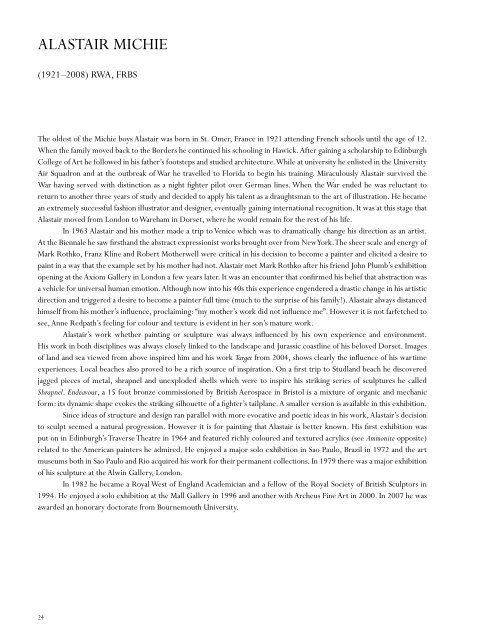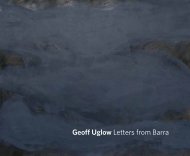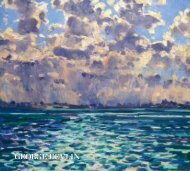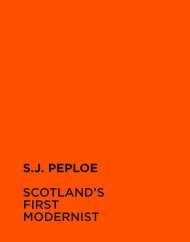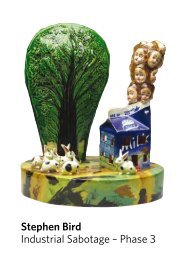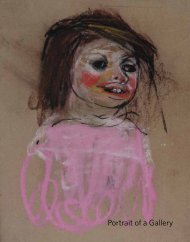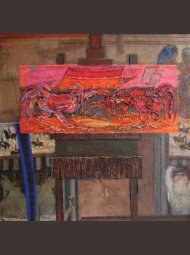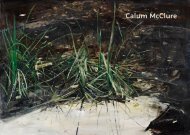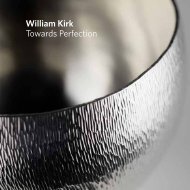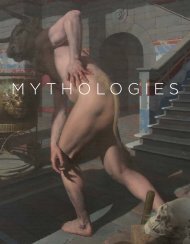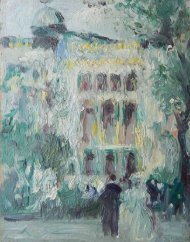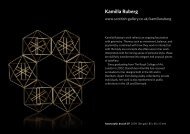Download a PDF of the exhibition catalogue - The Scottish Gallery
Download a PDF of the exhibition catalogue - The Scottish Gallery
Download a PDF of the exhibition catalogue - The Scottish Gallery
Create successful ePaper yourself
Turn your PDF publications into a flip-book with our unique Google optimized e-Paper software.
Alastair Michie<br />
(1921–2008) RWA, FRBS<br />
<strong>The</strong> oldest <strong>of</strong> <strong>the</strong> Michie boys Alastair was born in St. Omer, France in 1921 attending French schools until <strong>the</strong> age <strong>of</strong> 12.<br />
When <strong>the</strong> family moved back to <strong>the</strong> Borders he continued his schooling in Hawick. After gaining a scholarship to Edinburgh<br />
College <strong>of</strong> Art he followed in his fa<strong>the</strong>r’s footsteps and studied architecture. While at university he enlisted in <strong>the</strong> University<br />
Air Squadron and at <strong>the</strong> outbreak <strong>of</strong> War he travelled to Florida to begin his training. Miraculously Alastair survived <strong>the</strong><br />
War having served with distinction as a night fighter pilot over German lines. When <strong>the</strong> War ended he was reluctant to<br />
return to ano<strong>the</strong>r three years <strong>of</strong> study and decided to apply his talent as a draughtsman to <strong>the</strong> art <strong>of</strong> illustration. He became<br />
an extremely successful fashion illustrator and designer, eventually gaining international recognition. It was at this stage that<br />
Alastair moved from London to Wareham in Dorset, where he would remain for <strong>the</strong> rest <strong>of</strong> his life.<br />
In 1963 Alastair and his mo<strong>the</strong>r made a trip to Venice which was to dramatically change his direction as an artist.<br />
At <strong>the</strong> Biennale he saw firsthand <strong>the</strong> abstract expressionist works brought over from New York. <strong>The</strong> sheer scale and energy <strong>of</strong><br />
Mark Rothko, Franz Kline and Robert Mo<strong>the</strong>rwell were critical in his decision to become a painter and elicited a desire to<br />
paint in a way that <strong>the</strong> example set by his mo<strong>the</strong>r had not. Alastair met Mark Rothko after his friend John Plumb’s <strong>exhibition</strong><br />
opening at <strong>the</strong> Axiom <strong>Gallery</strong> in London a few years later. It was an encounter that confirmed his belief that abstraction was<br />
a vehicle for universal human emotion. Although now into his 40s this experience engendered a drastic change in his artistic<br />
direction and triggered a desire to become a painter full time (much to <strong>the</strong> surprise <strong>of</strong> his family!). Alastair always distanced<br />
himself from his mo<strong>the</strong>r’s influence, proclaiming: “my mo<strong>the</strong>r’s work did not influence me”. However it is not farfetched to<br />
see, Anne Redpath’s feeling for colour and texture is evident in her son’s mature work.<br />
Alastair’s work whe<strong>the</strong>r painting or sculpture was always influenced by his own experience and environment.<br />
His work in both disciplines was always closely linked to <strong>the</strong> landscape and Jurassic coastline <strong>of</strong> his beloved Dorset. Images<br />
<strong>of</strong> land and sea viewed from above inspired him and his work Target from 2004, shows clearly <strong>the</strong> influence <strong>of</strong> his wartime<br />
experiences. Local beaches also proved to be a rich source <strong>of</strong> inspiration. On a first trip to Studland beach he discovered<br />
jagged pieces <strong>of</strong> metal, shrapnel and unexploded shells which were to inspire his striking series <strong>of</strong> sculptures he called<br />
Shrapnel. Endeavour, a 15 foot bronze commissioned by British Aerospace in Bristol is a mixture <strong>of</strong> organic and mechanic<br />
form: its dynamic shape evokes <strong>the</strong> striking silhouette <strong>of</strong> a fighter’s tailplane. A smaller version is available in this <strong>exhibition</strong>.<br />
Since ideas <strong>of</strong> structure and design ran parallel with more evocative and poetic ideas in his work, Alastair’s decision<br />
to sculpt seemed a natural progression. However it is for painting that Alastair is better known. His first <strong>exhibition</strong> was<br />
put on in Edinburgh’s Traverse <strong>The</strong>atre in 1964 and featured richly coloured and textured acrylics (see Ammonite opposite)<br />
related to <strong>the</strong> American painters he admired. He enjoyed a major solo <strong>exhibition</strong> in Sao Paulo, Brazil in 1972 and <strong>the</strong> art<br />
museums both in Sao Paulo and Rio acquired his work for <strong>the</strong>ir permanent collections. In 1979 <strong>the</strong>re was a major <strong>exhibition</strong><br />
<strong>of</strong> his sculpture at <strong>the</strong> Alwin <strong>Gallery</strong>, London.<br />
In 1982 he became a Royal West <strong>of</strong> England Academician and a fellow <strong>of</strong> <strong>the</strong> Royal Society <strong>of</strong> British Sculptors in<br />
1994. He enjoyed a solo <strong>exhibition</strong> at <strong>the</strong> Mall <strong>Gallery</strong> in 1996 and ano<strong>the</strong>r with Archeus Fine Art in 2000. In 2007 he was<br />
awarded an honorary doctorate from Bournemouth University.<br />
24


